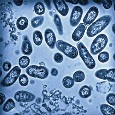
CDC Report Calls for New Foodborne Illness Strategies
A 10-state report released yesterday by the Centers for Disease Control and Prevention showed little change in the incidence of some foodborne infections after a period of decline. The findings are from 2007 data reported to CDC as part of the agency's Foodborne Diseases Active Surveillance Network, FoodNet.
FoodNet monitors foodborne disease and conducts related epidemiologic studies to help health officials better understand the epidemiology of foodborne diseases in the United States. Although the FoodNet population is similar to the U.S. population, CDC says the findings are used to detect trends in foodborne illness and should not be generalized for the entire U.S. population.
Campylobacter, Listeria, Salmonella, Shigella, E.coli O157, Vibrio, and Yersinia did not decline significantly, and the estimated incidence of Cryptosporidium increased when compared with the previous three years (2004-2006). Although there have been significant declines in the incidence of some foodborne infections since surveillance began in 1996, these declines all occurred before 2004.
"The results show that prevention efforts have been partly successful, but there has been little further progress in the most recent years," said Dr. Robert Tauxe, deputy director of CDC's Division of Foodborne, Bacterial and Mycotic Diseases. "More needs to be done to make our food safer. We are constantly working to help our public health system better detect, investigate and control outbreaks, and to understand how to prevent foodborne illnesses from happening in the first place. FoodNet is an important part of our food safety system and is how we measure progress."
CDC recommends that consumers reduce their risk for foodborne illness by following safe food-handling recommendations and by avoiding the consumption of unpasteurized milk, raw or undercooked oysters, raw or undercooked eggs, raw or undercooked ground beef, and undercooked poultry. The risk for foodborne illness can also be decreased by choosing in-shell pasteurized eggs, irradiated ground meat, and high pressure-treated oysters.
The full report, "Preliminary FoodNet Data on the Incidence of Infection with Pathogens Transmitted Commonly Through Food – 10 States, United States, 2007" appears in the April 11, 2008 edition of Morbidity and Mortality Weekly Report and is available online at www.cdc.gov/mmwr. To learn more about FoodNet, visit www.cdc.gov/foodnet.To learn more about foodborne infections, visit www.cdc.gov/ncidod/dbmd/diseaseinfo/foodborneinfections_g.htm.